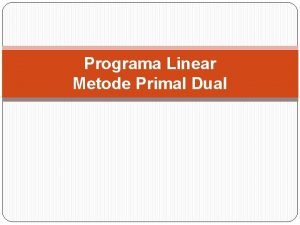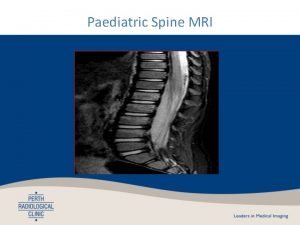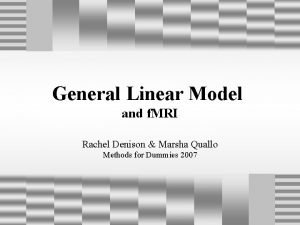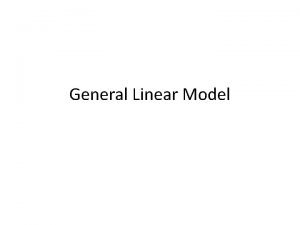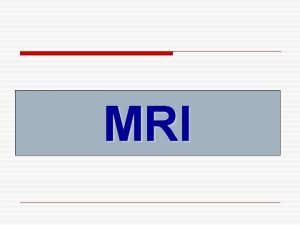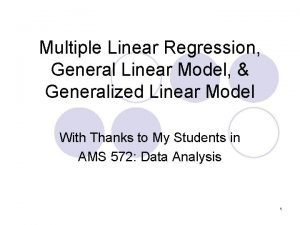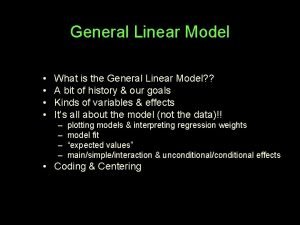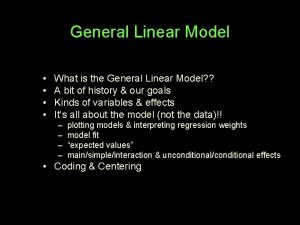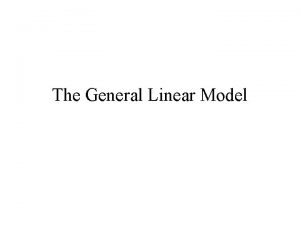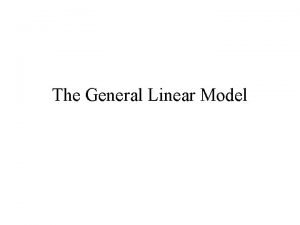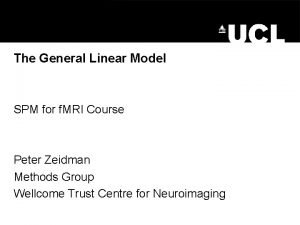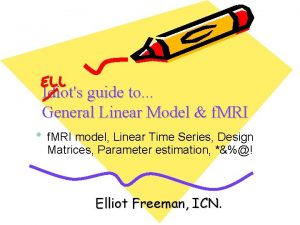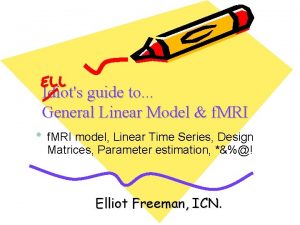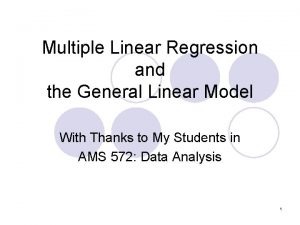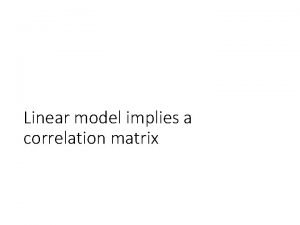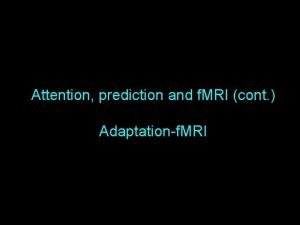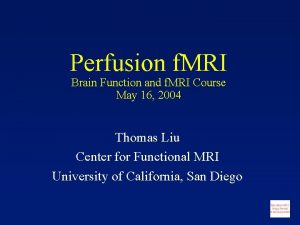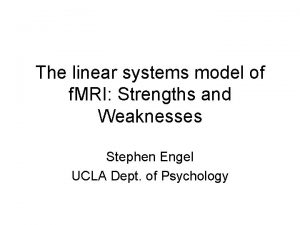General Linear Model and f MRI Rachel Denison





















![T-Tests and F-Tests c [1 0 0] c [1 -1 0] • A contrast T-Tests and F-Tests c [1 0 0] c [1 -1 0] • A contrast](https://slidetodoc.com/presentation_image/4cfe37f393549df92364a465cae41c58/image-22.jpg)

- Slides: 23

General Linear Model and f. MRI Rachel Denison & Marsha Quallo Methods for Dummies 2007

Did the experiment work? Did the experimental manipulation affect brain activity? A simple experiment: Passive Listening vs. Rest -- -- 6 scans per block time

The General Linear Model y = Xβ + ε β y = X + ε Observed data = Predictors * Parameters + Error eg. Image intensities Also called the design matrix. How much each predictor contributes to the observed data Variance in the data not explained by the model

y: Activity of a single voxel over time y = Xβ + ε y 1 y 2 =y … y. N One voxel at a time: time Mass Univariate BOLD signal

X in context β y = x 1 x 2 x 3 + ε Observed data = Predictors * Parameters + Error

X in context y = x 1 x 2 x 3 β 1 β 2 β 3 + ε Observed data = Predictors * Parameters + Error

X in context *β 1 y = x 1 + x 2 *β 3 + x 3 + ε A linear combination of the predictors y 1 = x 11*β 1 + x 12*β 2 + x 13*β 3 + ε 1

X: The Design Matrix -- y = Xβ + ε x 1 Conditions On Off On time Use ‘dummy codes’ to label different levels of an experimental factor (eg. On = 1, Off = 0). β is ANOVA effect size.

X: The Design Matrix y = Xβ + ε x 1 x 2 x 3 Covariates Parametric and factorial predictors in the same model! Parametric variation of a single variable (eg. Task difficulty = 1 -6) or measured values of a variable (eg. Movement). β is regression slope.

X: The Design Matrix y = Xβ + ε x 1 x 2 Constant Variable eg. Always = 1 Models the baseline activity

X: The Design Matrix The design matrix should include everything that might explain the data. Conditions: Effects of interest Subjects Global activity or movement More complete models make for lower residual error, better stats, and better estimates of the effects of interest.

Summary So far… y = Xβ + ε If you like these slides … Past Mf. D presentations (esp. Elliot Freeman, 2005); past FIL SPM Short Course presentations (esp. Klaas Enno Stephan, 2007); Human Brain Function v 2

Thanks!

General Linear Model: Part 2 Marsha Quallo

Content • • • Parameters Error Parameter Estimation Hemodynamic Response Function T-Tests and F-Tests

Parameters Y= Xβ + ε • β: defines the contribution of each component of the design matrix to the value of Y • The best estimate of β will minimise ε

Parameter Estimation 2 34 01 01 0 12 Listening Reading Rest ≈ β 1∙ 0 + β 2∙ 0 + β 3∙ 3

Parameter Estimation 2 34 01 01 0 12 Listening Reading Rest ≈ β 1∙ 1 + β 2∙ 0 + β 3∙ 4

Parameter Estimation 2 34 01 01 0 12 Listening Reading Rest ≈ β 1∙ 0. 83 + β 2∙ 0. 16 + β 3∙ 2. 98

Parameter Estimation To estimate β we need to find the least square fit for the line • β�= XTY(XTX)-1 y e e e x 2 x 1 x 3 • If X has linearly dependant columns the model will be over parameterised • Let (XTX)- denote the psuedoinverse of (XTX) then β�= (XTX)-XTY = X-Y

Hemodynamic response function Original Convolved HRF Original Convolved
![TTests and FTests c 1 0 0 c 1 1 0 A contrast T-Tests and F-Tests c [1 0 0] c [1 -1 0] • A contrast](https://slidetodoc.com/presentation_image/4cfe37f393549df92364a465cae41c58/image-22.jpg)
T-Tests and F-Tests c [1 0 0] c [1 -1 0] • A contrast vector is used to select conditions for comparison ~ T= cβ ~ Var(cβ) • What about c [1 1 0] • A contrast matrix is used to make a simultaneous test of multiple contrasts c= ( ) F= 100 010 ~ cβ = (1 B 1 + 0 B 2 + 0 B 3) ~ ~ βc(Var[cβ])-1 cβ K

• http: //www. fil. ion. ucl. ac. uk/spm/course/slides 06/ppt/glm. ppt#374, 1, Modelling Neuroimaging Data Using the General Linear Model (GLM©Karl) Jesper Andersson KI, Stockholm & BRU, Helsinki • http: //www. fil. ion. ucl. ac. uk/spm/doc/mfd-2005/GLM_f. MRI. ppt • http: //www. fil. ion. ucl. ac. uk/spm/doc/books/hbf 2/ • Functional MRI: an introduction to methods. Jezzard, P; Matthews, PM; Smith, SM
 Deaf culture
Deaf culture Denison organizational culture survey
Denison organizational culture survey Shelby denison
Shelby denison Denison university library
Denison university library General linear model minitab
General linear model minitab Kovariaatti
Kovariaatti Weather model of reflection
Weather model of reflection Linear regression vs multiple regression
Linear regression vs multiple regression Non linear text
Non linear text Foreshadowing is a nonlinear element of plot that:
Foreshadowing is a nonlinear element of plot that: Which pipeline is linear
Which pipeline is linear Linear and nonlinear in multimedia
Linear and nonlinear in multimedia Linear impulse and momentum
Linear impulse and momentum Contoh soal persamaan simultan 3 variabel
Contoh soal persamaan simultan 3 variabel Convert right linear grammar to left linear grammar
Convert right linear grammar to left linear grammar Difference between linear and nonlinear
Difference between linear and nonlinear Simultaneous equations linear and non linear
Simultaneous equations linear and non linear Linear models of communication
Linear models of communication Model primal dan model dual program linear
Model primal dan model dual program linear Diferencia entre gran plano general y plano general
Diferencia entre gran plano general y plano general Where did general lee surrender to general grant?
Where did general lee surrender to general grant? Freesurfer group analysis
Freesurfer group analysis Mri gp indications
Mri gp indications Mıknatıslı septum
Mıknatıslı septum


















